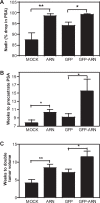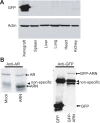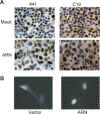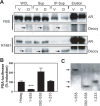Inhibition of androgen receptor by decoy molecules delays progression to castration-recurrent prostate cancer
- PMID: 28306720
- PMCID: PMC5357013
- DOI: 10.1371/journal.pone.0174134
Inhibition of androgen receptor by decoy molecules delays progression to castration-recurrent prostate cancer
Abstract
Androgen receptor (AR) is a member of the steroid receptor family and a therapeutic target for all stages of prostate cancer. AR is activated by ligand binding within its C-terminus ligand-binding domain (LBD). Here we show that overexpression of the AR NTD to generate decoy molecules inhibited both the growth and progression of prostate cancer in castrated hosts. Specifically, it was shown that lentivirus delivery of decoys delayed hormonal progression in castrated hosts as indicated by increased doubling time of tumor volume, prolonged time to achieve pre-castrate levels of serum prostate-specific antigen (PSA) and PSA nadir. These clinical parameters are indicative of delayed hormonal progression and improved therapeutic response and prognosis. Decoys reduced the expression of androgen-regulated genes that correlated with reduced in situ interaction of the AR with androgen response elements. Decoys did not reduce levels of AR protein or prevent nuclear localization of the AR. Nor did decoys interact directly with the AR. Thus decoys did not inhibit AR transactivation by a dominant negative mechanism. This work provides evidence that the AR NTD plays an important role in the hormonal progression of prostate cancer and supports the development of AR antagonists that target the AR NTD.
Conflict of interest statement
Figures







Similar articles
-
Androgen receptor decoy molecules block the growth of prostate cancer.Proc Natl Acad Sci U S A. 2007 Jan 23;104(4):1331-6. doi: 10.1073/pnas.0606718104. Epub 2007 Jan 16. Proc Natl Acad Sci U S A. 2007. PMID: 17227854 Free PMC article.
-
Regression of castrate-recurrent prostate cancer by a small-molecule inhibitor of the amino-terminus domain of the androgen receptor.Cancer Cell. 2010 Jun 15;17(6):535-46. doi: 10.1016/j.ccr.2010.04.027. Cancer Cell. 2010. PMID: 20541699
-
Carbidopa abrogates L-dopa decarboxylase coactivation of the androgen receptor and delays prostate tumor progression.Int J Cancer. 2012 Jun 15;130(12):2835-44. doi: 10.1002/ijc.26287. Epub 2011 Sep 14. Int J Cancer. 2012. PMID: 21780103
-
Androgen receptors in hormone-dependent and castration-resistant prostate cancer.Pharmacol Ther. 2013 Dec;140(3):223-38. doi: 10.1016/j.pharmthera.2013.07.003. Epub 2013 Jul 13. Pharmacol Ther. 2013. PMID: 23859952 Review.
-
Molecular biology of castration-resistant prostate cancer: basis for the novel therapeutic targets.Arch Esp Urol. 2013 Jun;66(5):453-62. Arch Esp Urol. 2013. PMID: 23793763 Review.
Cited by
-
Therapeutic Potential of Decoys for Prostate Cancers: A Review of Recent Updates.Curr Med Chem. 2024;31(25):3954-3965. doi: 10.2174/0929867330666230505154319. Curr Med Chem. 2024. PMID: 37151059 Review.
-
An Amyloidogenic Sequence at the N-Terminus of the Androgen Receptor Impacts Polyglutamine Aggregation.Biomolecules. 2017 Jun 19;7(2):44. doi: 10.3390/biom7020044. Biomolecules. 2017. PMID: 28629183 Free PMC article.
-
Revealing Metabolic Liabilities of Ralaniten To Enhance Novel Androgen Receptor Targeted Therapies.ACS Pharmacol Transl Sci. 2019 Sep 26;2(6):453-467. doi: 10.1021/acsptsci.9b00065. eCollection 2019 Dec 13. ACS Pharmacol Transl Sci. 2019. PMID: 32259077 Free PMC article.
-
Gene Expression Signature Predictive of Neuroendocrine Transformation in Prostate Adenocarcinoma.Int J Mol Sci. 2020 Feb 6;21(3):1078. doi: 10.3390/ijms21031078. Int J Mol Sci. 2020. PMID: 32041153 Free PMC article.
-
Drugging the Undruggable: Targeting the N-Terminal Domain of Nuclear Hormone Receptors.Adv Exp Med Biol. 2022;1390:311-326. doi: 10.1007/978-3-031-11836-4_18. Adv Exp Med Biol. 2022. PMID: 36107327
References
-
- Jenster G, van der Korput HA, Trapman J, Brinkmann AO. Identification of two transcription activation units in the N-terminal domain of the human androgen receptor. J Biol Chem. 1995; 270(13),7341–7346. - PubMed
-
- Cleutjens KB, van Eekelen CC, van der Korput HA, Brinkmann AO, Trapman J. (1996) Two androgen response regions cooperate in steroid hormone regulated activity of the prostate-specific antigen promoter. J Biol Chem. 1996;271(11),6379–6388. - PubMed
MeSH terms
Substances
Grants and funding
LinkOut - more resources
Full Text Sources
Other Literature Sources
Medical
Molecular Biology Databases
Research Materials
Miscellaneous

